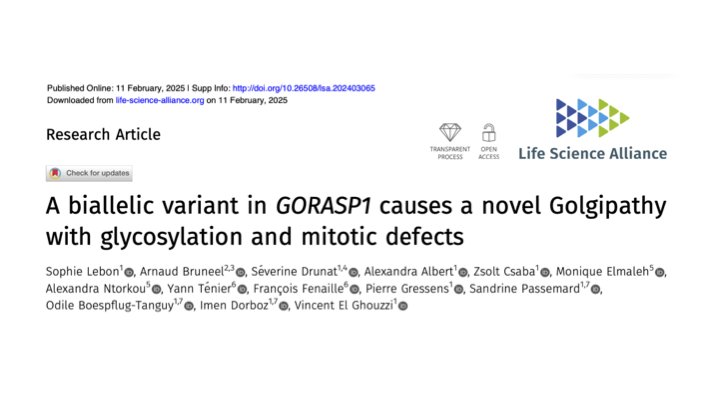Mitochondria and NDD
Involvement of mitochondrial dysfunction in neurodevelopment diseases (NDDs) and the design of mitochondria-targeted therapies

Confocal images from cerebellar sections labeled with DAPI (blue), Neuroglobin, NGB (green) and Calbindin, a specific marker of cerebellar Purkinje cells, CALB (red) are illustrated. Scale bars correspond to 25 µm (63X objective). Abbreviations: ML, molecular layer; GL, granular layer; PC, Purkinje cells.
Left panel: a control mouse treated with the AAV2/9-Ngb vector, a Harlequin mouse treated with the AAV2/9-Ngb vector and a Harlequin mouse treated with the AAV2/9-GFP vector.
Right panel: one untreated Wild-type mouse, one Atxn1 mouse treated with the AAV2/9-Ngb vector and one untreated Atxn1 mouse.
Mutations in genes encoding mitochondrial proteins lead to primary mitochondrial disorders, which represent one of the most common and debilitating inherited metabolic diseases often resulting in early mortality. Patients with mitochondrial diseases suffer from multi-systemic symptoms, especially affecting organs with high energetic demands such as the brain, muscle, heart, retina, optic nerve, and liver. There is no cure or approved therapy currently available for mitochondrial diseases, certainly due to the complexity of phenotypes associated with mitochondrial dysfunction. Moreover, over the past decades, an emerging role for mitochondrial dysfunction and altered energy metabolism has been associated to the pathogenesis of neurodevelopmental and neurodegenerative disorders. This can be explained by the high energy requirements of neurons and their inability to produce sufficient ATP by glycolysis, resulting in their dependence on functional mitochondria for their integrity.
Our research project aims at improving life conditions of patients suffering from neurological diseases by preserving mitochondrial homeostasis by implementing a treatment, via gene therapy, which effectively and durably preserves the functional integrity of mitochondria within neurons.
The gene therapy candidate chosen is the Neuroglobin because we have already demonstrated its capacity to protect the optic nerve and the cerebellum of the Harlequin mice, which faithfully recapitulates Human mitochondrial diseases.
The neuroglobin was identified, in 2000, as a member of the globin superfamily which is highly conserved throughout evolution and possesses neuroprotective properties. We were involved in demonstrating its localization inside the mitochondria of rodent neurons and its ability to protect respiratory chain function.
To consolidate the proof-of-concept that neuroglobin gene overexpression is beneficial not only for mitochondrial diseases but also for neurological disorders in which symptoms aggravate consecutive to mitochondrial damage we are studying the cerebellum and cerebellar ataxia not due to mitochondrial gene mutations, the Atxn1154Q/2Q mice.
If this treatment effectively and permanently preserves mitochondrial homeostasis of cerebellar neurons in Atxn1154Q/2Q mice, we will strengthen our hypothesis and open the way to design a clinical study involving the neuroglobin.
Members
Edward Ratcliffe (PhD fellow)
Djmila Mouri (PhD fellow)
Dr. Isabel Torres-Cuevas (15%)
Ivan-Millan (Post-doc fellow, 50%)
Marisol Corral-Debrnski (Director of Research CNRS)
Recent Publications
1. H. Cwerman-Thibault, V. Malko-Baverel, G. Le Guilloux, I. Torres-Cuevas, E. Ratcliffe, D. Mouri, V. Mignon, B. Saubaméa, O. Boespflug-Tanguy, P. Gressens, M. Corral-Debrinski. Biochim Biophys Acta Mol Basis Dis (2024) 17:167272. DOI: 10.1016/j.bbadis.2024.167272.
2. H. Cwerman-Thibault, V. Malko-Baverel, G. Le Guilloux, E. Ratcliffe, D. Mouri, I. Torres-Cuevas, I. Millán, B. Saubaméa, V. Mignon, O. Boespflug-Tanguy, Pierre Gressens, Marisol Corral-Debrinski. Mol Ther. 2024: S1525-0016(24)00332-0. DOI: 10.1016/j.ymthe.2024.05.030.
3. H. Cwerman-Thibault, C. Lechauve, V. Malko-Baverel, S. Augustin, G. Le Guilloux, É. Reboussin, J. Degardin-Chicaud, M. Simonutti, T. Debeir, M. Corral-Debrinski. Neurobiol Dis. (2021) 159: 105483. DOI: 10.1016/j.nbd.2021.105483.
Collaborations
Dr. Isabel Torres-Cuevas: Neonatal Research Group of the Health Research Institute La Fe (Valencia, Spain)
Dr. Bruno Saubamea: the Université de Paris, UMR-S 1144 Inserm, Platform of Cellular and Molecular Imaging (Paris)
Dr. Consuelo Chafer-Pericas: Research Group in Alzheimer Disease, Health Research Institute La Fe (Valencia, Spain)
Funding
AFM-Telethon as a strategic project (NEUROGLOBIN & NEUROPROTECTION)
Intellectual Property
PCT/EP2023/068369 / WO2024008709: Intravenous administration of neuroglobin for treating neurological disorders.
Contacts
Marisol Corral-Debrinski
UMR Inserm 1141 – NeuroDiderot
Hôpital Robert Debré
48 boulevard Sérurier
75 019 Paris
Marisol.@corralinserm.fr
Read more
Conference Danielle Beckman Friday 28 November 2025
séminaire Danielle Beckman _28-nov-2025 english
Conference Dr. Julien Courchet Thursday 20 november 2025
séminaire Julien Courchet _20-nov-2025 english
Conference Dr. Alexandra Benchoua Thursday 27 november 2025
séminaire A-Benchoua _27-nov-2025 english

New Golgipathy identified in NeuroDev team
The NeuroDev team publishes an article in Life Science Alliance [1] identifying the first human pathogenic variant of GORASP1, the gene encoding the Golgi stacking protein GRASP65, and demonstrating its consequences on glycosylation and mitotic progression. [1] S....
